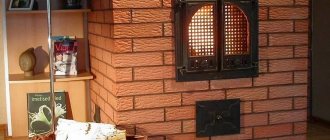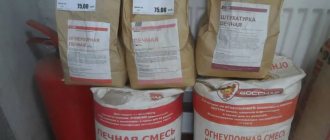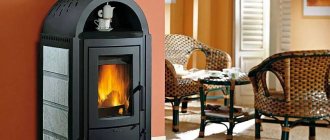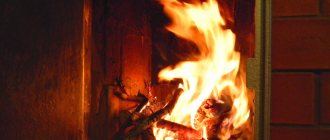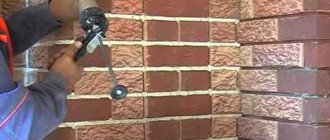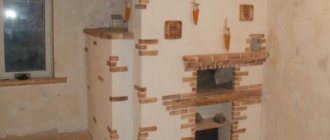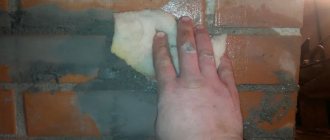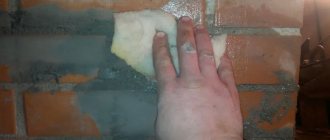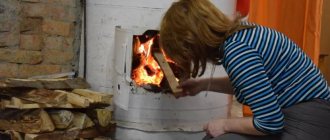Such a popular material as clay is actually a sedimentary rock. In the initial state, clay is a dusty powder, but when water is added it acquires plastic properties. The composition of clays can vary significantly, since in addition to the main components they contain various impurities. Typically, the base is made up of substances such as kaolinite, montmorillonite, and silica sand.
It is the composition that largely determines the plastic properties of the final material.
Why does clay crack?
One of the common reasons is an excessively thick seam.
The surface of the clay layer can crack for various reasons, and yet, why this happens, we will consider the probable reasons and find out what to do to prevent the clay from cracking when drying:
- excessively thick layer. To avoid this, plaster with clay, applying a maximum two-centimeter layer. If there is a need to apply a second one, then the previous one should set well. In good weather, this takes at least a day. If it is intended to apply a plaster layer more than four centimeters thick, the surface must be reinforced with steel mesh;
- the plaster dries too quickly and begins to crack. Optimal conditions for this are 10 – 20 degrees Celsius. If the weather is hot, it is recommended to suspend work and moisten the walls more often. Perhaps the base of the wall quickly absorbs moisture. In this case, it is also moisturized abundantly;
- the solution turned out to be too greasy. Replace the clay or reduce its amount in the solution. The same applies to cement material.
Reasons for furnace failure
Before looking for the best way to fix the problem, it is necessary to determine the causes of cracks. It could be:
• low quality of the solution used;
• violation of finishing technology;
• shrinkage of the brick structure;
• non-compliance with the rules for operating the stove.
If the stove sank due to an improperly poured foundation, smoke will pour out of all the cracks during the fire, the doors will no longer close tightly, and the brick will gradually begin to collapse. If such problems are discovered, you should immediately dismantle the entire structure, strengthen the foundation and lay it out again. However, in some cases you can do without radical measures.
All other reasons can be easily eliminated; it is only important to figure out how to cover the stove so that it does not crack.
Types of clay-based plasters
Let's consider the main options for plasters and the technology for their preparation.
Fireclay clay
Fireclay clay
Difficulties arise in the work, the bricks hold weakly in the masonry, the plaster layer is covered with numerous cracks. This is due to the fact that during the firing process the clay almost completely loses its plasticity, which must be returned to it when preparing the solution. In these cases, craftsmen recommend adding quartz sand or a special adhesive composition. The procedure for preparing the solution is as follows:
- you will need a pack of fireclay powder, which is poured into a container;
- water is added gradually until it covers the entire mass;
- it is necessary to wait three days for the material to infuse;
- after this sand is added. If the solution turns out to be thick, you can add water, otherwise the clay layer will crack when it dries;
- The mass is thoroughly mixed.
A properly prepared solution should resemble thick sour cream in thickness, only in this case it will not drain and will adhere perfectly to the surface. To speed up the drying process and take measures to prevent the clay from cracking, it is necessary to add cement at the rate of two kilograms per package of fireclay.
It is possible to purchase ready-to-mix formulations that do not require steeping for three days.
Clay-sand mortar
How to properly make such a solution so that the clay does not crack? First you need to sift the sand, for which you will need a sieve with a hole size of 2 - 3 mm. Its amount will depend on the degree of fat content of the clay.
The clay is pre-soaked. It is placed in a tank and filled with water, leaving for one to two days. After this, the mass is mixed and passed through a three-millimeter sieve. The result should be a solution that is similar in thickness to sour cream.
We start adding sand. As a rule, one and a half times more sand is required per liter of solution. But when the clay is oily and the solution is prepared in such proportions, then cracks will definitely appear. And with low-fat clay, the layer of plaster will not be durable.
The ratio of sand and clay should be accurately determined. For this purpose, take a liter of solution, to which sand is added in doses, while stirring the mass. The end result should be a material that easily slides off a metal shovel, but does not spread over it.
Clay-sand mortar
Clay-sand mortar with added fiber
What other clay solution can be used to cover the stove so that it does not crack? To do this, a small amount of cement is added to the working composition - a trowel per bucket.
If it is necessary to coat the stove to seal cracks, add simple table salt to the solution - up to five hundred grams per bucket. This gives the mixture strength and allows it to be more reliably held on the masonry surface.
Some craftsmen add a small amount of sheet asbestos soaked in water to the mortar mass. It is simply torn into small pieces and soaked in water. After a few minutes, the asbestos separates into individual fibers that reinforce the solution. The slurry obtained in this way is added to a solution of sand and clay, mixed and used as the first coating layer.
How to avoid cracks
When working with ceramics, maximum attention is required from the master. Not all of his efforts should be aimed at obtaining the finished form of the product and the result of decoration. Throughout the entire process, he must constantly ensure that no defects form on the surface of the product, this applies not only to the drying or firing stage. We can formulate several tips for correct operation, which directly follow from the main causes of clay cracking.
- All materials purchased in specialized stores are almost ready for use. However, the manufacturer gives certain recommendations for working with them. You must strictly adhere to the instructions received. If you want to be creative and change the technology, then it is best to experiment in small batches.
- It is recommended to achieve uniform thickness of the workpiece. A pottery compass or other suitable measuring device can be used to measure wall thickness. If, nevertheless, the master wishes to make products with walls of different thicknesses, he must ensure that the main plastic mass dries evenly. It often happens that a ceramist discovers thickenings after sculpting, that is, when the clay begins to dry out. In this case, you need to wait until the top layer dries so that it can be treated with sandpaper. Additional grooving is carried out in stages. First, the dried layer is removed, and then a certain time is waited until the next layer dries.
- An experienced craftsman knows how to regulate the speed of drying ceramics. For example, you can slow down the drying of clay by placing the workpiece in a cool place. It is important that there are no drafts in the room, since the presence of wind is known to increase the rate of moisture evaporation. If drying is carried out in winter, then it is better to keep the products away from radiators. To increase the air humidity in the room, special humidifiers are used, but you can also humidify the ceramics themselves directly.
To speed up the drying of the clay, some craftsmen use a hairdryer. But it is necessary to dry clay artificially with extreme caution, since there is a high probability of uneven drying of the surface. In order for the drying to be uniform, it is necessary to place the product on moisture-absorbing surfaces. These are gypsum surfaces. Under no circumstances should you use plastic. As a last resort, you can take several layers of newspaper. If possible, ceramic products should be covered with a bag or glass. Thus, the walls of the product remain moister, and air access is provided to the bottom of the product.
Nuances of testing clay plasticity
Different clays differ in their plasticity. There are:
- “fat” clays with high plasticity;
- material of medium ductility;
- “lean” clays with a low level of plasticity.
I determine the level of plasticity using a simple method. The clay is poured with water to turn it into a dough-like mass suitable for molding. The material is used to make cylinders seven centimeters long and 30 mm in diameter, the ends are pinched with fingers and slowly torn apart. Plasticity is judged by the shapes that the cylinder takes at the point of rupture, by its elongation. A plastic material is characterized by the formation of a long and thin neck, and if the clay is thin, the neck will be thick and short.
The level of plasticity is determined in another way. Flagella about twenty centimeters long and 1.5–2 mm in diameter are rolled out of the working material and bent into semicircles or pretzels. If cracks appear on the materials at this time, the clay is thin. Cracks that form during bending indicate that the clay is of medium plasticity, and fatty clay can be identified by the complete absence of cracks in the samples.
Caring for your stove
Caring for the stove
Now you know what you can use to coat the stove to prevent it from cracking. You should take care of your stove in a timely manner to prevent the formation of large cracks. Firstly, it is easier to cover up small defects, and secondly, this will help prevent the formation of large defects and ensure the safe operation of your stove.
Like any repair work, repairing cracks in the stove will require time and investment. But anyone can handle this task, because it does not require special qualifications, special tools and materials. The experience gained in sealing cracks on your stove may well be useful in its further operation. And clay for work and a little sand can be found at any time of the year, as a last resort, in a store in your area. And if you are planning to get your own fireplace, then the knowledge gained will be even more useful, because stoves and fireplaces have a lot in common.
https://youtube.com/watch?v=SG3XatSH3eU
Advantages and disadvantages of clay compositions
The following features are highlighted as advantages:
- clay is a natural and environmentally friendly product;
- solutions perfectly absorb water and release it, which prolongs the service life of coatings;
- reasonable cost;
- the remains of the used solution are stored for a long time;
- the material perfectly protects the surface from mechanical impacts;
- the elasticity of the material allows it to be applied without any problems;
- Not only internal, but also external surfaces are finished with a clay mixture;
- using the solution, level and decorate the surfaces.
In addition to the positive aspects, clay-based plaster has a number of disadvantages, which explain most cases why clay cracks:
- There is no exact recipe for preparing the solution; craftsmen prepare the mixture using their own experience;
- there is a possibility that the surface will become covered with cracks;
- Such compositions are rarely used; there are few experienced craftsmen who know how to cover a stove with clay so that it does not crack.
Dust
In order not to later wonder what to do if the plaster on the walls cracks, you need to remove dust from the surfaces treated with it in advance, and to the maximum. Its presence significantly impairs the adhesion of the liquid solution, as a result of which cracks will certainly appear on the walls or ceiling, albeit not immediately.
It is worth noting that it is not at all necessary to dust all walls and ceilings. It is enough to moisten them a little from a spray bottle, but only before starting finishing work, and not in advance.
Gypsum plaster: subtleties of use
The answer to why gypsum plaster cracks literally immediately after drying sounds different than in the situation with its cement-sand counterpart. In this situation, the primary sources of defects are as follows:
- Gypsum plaster cracks when drying where the surfaces being treated have not undergone rough preparation. That is, cracks and voids were not removed from them, into which gypsum would then gradually penetrate, causing ruptures in the decorative layer.
- Excess water is why plaster on walls cracks, because gypsum mixtures are extremely susceptible to large amounts of moisture, which weakens their structure. This is especially true when a slightly dried working solution is diluted with water.
- Another important indicator is the thickness of the applied layer, which cannot be less than 0.5 cm. Otherwise, the moisture will evaporate very quickly and the coating will inevitably “tear”.
It turns out that cracking of plaster is the result of an irresponsible attitude towards its use and disregard for the recommendations specified by the manufacturers. In general, this is a fairly easy-to-use coating that allows you to make a budget-friendly, high-quality, and most importantly, environmentally friendly base for future decorative coating.
Clay plaster, the composition of which is simple and literally lies under our feet, is increasingly found on construction sites as a facing material for interior and exterior decoration. It is known that it was the main material for masters many centuries ago, why are we returning to this experience again today?
Criteria for choosing a solution
Previously, classical solutions were used, taking into account combinations of heat resistance, increased heat capacity and thermal expansion equal to the brick material. To make such solutions, fatty clay was used.
Today you can purchase dry mixtures, certain types of clays and other compositions that simplify construction and repair work. It should be noted that not every such composition has the necessary characteristics - fire resistance, heat resistance, gas tightness.
The solution must be heat resistant, withstand high temperatures and exposure to chemically active substances. In addition, the gas density level must be quite high. The seams do not allow flue gases to pass through, but moisture must pass through the finished mixture for the stove to “breathe.”
Grout
To seal a brick oven, you can purchase a special grout. In stores there are various formulations that are produced specifically for these purposes. It’s worth noting right away that this option will cost you quite a lot, however, it is optimal for lining stoves and fireplaces.
If you cannot afford to purchase a specialized composition, prepare it at home. To do this you will need the following components:
The clay needs to be thoroughly kneaded, filled with water and set aside for 12 hours. After the specified time has passed, the required amount of sand should be added to the mixture. In the process of kneading the two components, finely chopped straw and salt are gradually added to them. Clay and sand are taken in a ratio of 4:1, with about 50 kg of straw and a pack of salt added for every 4 buckets of clay.
The resulting composition can withstand temperatures of more than 1000 degrees.
Instructions for applying clay plaster
The work is performed in the following sequence:
- mortar cakes are applied along the wall at regular intervals, and the material is stretched over the entire surface with a wide spatula, a rule or a trowel;
- Evenness is checked using a level. If necessary, apply a second layer;
- the surface is given time to dry completely: from 1 to 3 months, depending on the season;
- finishing is being carried out. To do this, use a solution consisting of clay, cement and sand in a ratio of 1 to 1 to 3. The mixture is applied in a thin layer and leveled. After three to four weeks, the stove can be whitewashed with lime.
We now know how to coat a stove with clay so that it does not crack. But you should know that half the success depends on the correct preparation of the solution.
Determining the extent of damage
Before getting started, you should consider the damage and determine the scope of work. If small cracks appear on the surface of the stove (even if in large numbers), to eliminate them you will need to remove the lining and clean the brick from the plaster.
For these purposes, you can use one of the following mixtures:
• made of clay and sand;
• from special grouts for ovens;
• made of fireclay clay;
• from oven glue.
Can’t decide what to cover the stove with to prevent it from cracking? Consider each option individually.
Alternative methods
A more radical way to get rid of cracks is to install an aluminum frame or another metal. To do this, you need two metal sheets, scissors for cutting metal, and corners. The size of the sheet is measured based on the height and length of the surface to be repaired, cut out and applied to the oven. The sheet is secured at the top and sides with metal corners. After installation, the frame can be painted.
In addition, you can line the stove surface with ceramic tiles. It can also be attached to the top of the frame, but if the cladding is done poorly, cracks will still appear on the stove, only under the tiles.
The main causes of cracks when drying ceramics:
poor-quality ceramic paste
As a result, the clay in the product has a different density and, as a result, a different drying rate, about the consequences of which read further.
different thickness of walls and bottom
When dried, the ceramic mass shrinks, that is, it becomes deformed, and this leads to stress in the material. Therefore, uniform drying is extremely important for ceramics, that is, so that natural deformation evenly affects the entire product.
If the bottom is thicker than the walls, then during natural drying the thin walls dry faster than the bottom, and in this case we are no longer talking about uniform drying. Thus, the product cannot be deformed evenly or bonded, which usually results in a crack at the bottom resembling an “S” shape.
air temperature and humidity
In winter, as a rule, the temperature in the room is quite high, and the relative humidity, on the contrary, is low, and the clay “behaves” differently than in the summer.
What is product drying from a physics point of view? Water is brought from the inner layers to the surface as a result of capillary effect, from where it evaporates. Under normal conditions, this process occurs slowly and, accordingly, evenly.
When the air is dry, water from the surface evaporates faster than moisture has time to penetrate to the surface from the inner layers. That is, the outer surface is no longer plastic, and the inner layer remains damp and unstable. Consequently, the inner layer of the material shrinks when it dries, which leads to stress and, as a consequence, cracks.
Best answers
Garni Pop:
Now listen to the correct answer from a professional. To "loosen" oily clay, add up to 30% fired clay. Sand causes problems during cooking, so it is not used. The mixture is called CHAMOT. This mass can be up to 10 cm thick if it dries slowly. The refractory shrinkage of fireclay is also small, which is why all monumental ceramics are made from it.
Veloria Granta:
yolk and possibly liquid glass
VASILY gets access:
add regular sand, and the proportions depend on the purpose
Doctor Man:
The drying method, plasticizer additives, including organic ones, depend on the purpose and further technological process: firing, coating, etc.
Vladimir Ivanov:
Guys, don't worry: Asbokroshka has been added.
Konstantin:
if the clay cracks when drying. it means it is “oily”. sifted sand is added. better than river...
Anastasia Babashkina:
Sand is sand, but there is a similar point: the clay needs to be finely crushed, all in parts, in order to remove all the fragments of stones, glass, and debris from it. Because it is because of foreign bodies that in half the cases the product cracks, and even during cooking it simply falls apart.
Craft product Modeling Need help Hello dear craftsmen and craftswomen Need your advice Clay
Even with instructions.
Nadezhda was very happy and immediately began sculpting.
This is what she made. But as it dried, the clay began to crack and literally fall apart.
Yellow cosmetic clay, bought at a pharmacy (you can’t go to any lengths to make a child happy).
The flowers fell off almost immediately.
Just pick it up and you are left with a piece of the craft “as a keepsake.”
She also made such a dog as a gift for my sister.
But unfortunately, all that was left of her were photographs. The dog itself fell apart and we couldn’t put it back together.
Thanks to everyone who stopped by. And special thanks to those who will help solve our problem. Maybe she did something wrong? Maybe wet it with more water? Maybe we shouldn’t touch the craft until it’s completely dry? Or there are other secrets that we don’t know about. I myself have never worked with clay and cannot give any advice.
buy self-hardening clay at a craft store that does not require firing. You most likely bought a different material than your child had previously worked with. Don’t despair. Try to find a good store with a good sales consultant and don’t hesitate and take your time to look at everything what they will offer you. I wish you and Nadyusha creative success!
Thank you. There was another clay in the store, light, probably just self-hardening. It’s just that this one weighed 1 kg, and that one was already 2.5 kg. So I didn't take it. I'll go and have a look again.
Try to sculpt something flat; you need to dry the clay on a plastic board, on glass, on hardboard, on something that does not deform when drying.
And come visit, maybe you will find useful information)) https://stranamasterov.ru/node/196219 Thank you very much for the advice. My daughter will come home from school, we’ll definitely go in and have a look.
I'm very sorry about your crafts.
Thanks for the advice. We tried the dough. somehow it didn’t go very well either. At first she was delighted with the dough and began to sculpt, but the layer was thick and it also cracked. So the cat was left unpainted, but I didn’t throw it away. lies now waiting in the wings.
I completely agree with Firefly. I would also like to add that it is good to dry clay products on newspaper, it absorbs moisture.
There are often pebbles in it, which can also cause the product to crack.
Svetlana, thanks for the advice. We will definitely use it and try to sculpt again, perhaps during the holidays. And now we need to finish the quarter and half of the year. I really liked your work. Especially tea and coffee fish.
Thank you so much for the tips! But new questions have arisen again. How to determine whether the work is dry or not? And I really want to try to burn it, but how to do it? It says in a muffle furnace, but at home there is only a household gas furnace, and the temperature in it is only up to 240 degrees, but it should be more than 800. And how long does it take to fire? I would be very grateful if you could help me with this as well.
Thank you. We are also just starting, or rather, only our daughter for now, and I’m thinking of joining her later.
Source
If the goal is to achieve uniform drying, then proceed as follows:
First of all, the product must be placed with its bottom on a moisture-absorbing surface; the classic option is a plaster circle or plaster stand. But plastic will not work. As a last resort, you can put regular newspaper, which, due to its “looseness,” absorbs moisture very well.
Our next task is to ensure uniform drying of the walls and bottom. When drying, ceramics are sometimes placed in bags or covered with glass caps.
The main reason why cracks appear on ceramics is uneven drying. This can be avoided by using various methods and ensuring uniform drying of the product throughout its entire thickness.
For uniform drying, the thin wall needs to dry in the same amount of time as the thicker bottom. Therefore, the optimal option is when the walls of the product are covered (a plastic bag selected according to size is quite suitable), and air access is provided to the bottom.
However, here you need to take into account the dimensions and not leave the drying ceramics unattended, periodically checking the uniformity of drying of the mass throughout the product.
Source
How can you plaster a stove to prevent it from cracking: types and types
Plaster for stoves and fireplaces should be chosen carefully. Finishing the surface with typical building materials is unwise. Due to the variability of temperatures and their increased coefficient, heat-resistant brick oven plaster is selected. Elasticity indicators are also important in order to prevent cracking and crumbling of the walls during the firing of furnace equipment.
To plaster the structure, it is advised to buy a ready-made mixture for plastering stoves. An important component is clay of medium fat content, without the introduction of sand and extrusion.
How to plaster the stove to prevent it from cracking? There are different types of primer raw materials.
Heat-resistant type - has a general purpose to plaster the stove. The composition is selected for a temperature of 200 degrees. Finishing can be carried out by covering the entire heating area, not including the cooking zone and oven. A Russian stove, an English fireplace, or a bathhouse can also be completely plastered using a heat-resistant solution. Fireproof mixture - can withstand contact with open fire for a certain period of time, about 20 minutes. Fire-resistant plaster can also withstand indefinitely
When purchasing, these names are often confused, but this does not matter for the material, since the firebox and chimney are not plastered. The front part of the structure with an open firebox is coated with a refractory compound. Heat-resistant composition - can withstand temperatures of more than 800 degrees, in contact and without contact with the flame
Heat-resistant material is used to finish the cooking area, which has a very strong heating system and difficult braking dynamics. It is useful to partially cover with heat-resistant plaster for stoves and fireplaces, 20-30 cm away from the exit of metal parts that can heat up to 400 degrees.
Heat-resistant composition - can withstand temperatures of more than 800 degrees, in contact and without contact with the flame. Heat-resistant material is used to finish the cooking area, which has a very strong heating system and difficult braking dynamics. It is useful to partially cover with heat-resistant plaster for stoves and fireplaces, 20-30 cm away from the exit of metal parts that can heat up to 400 degrees.
Simple DIY mixtures
It may be the case that for lower costs it is better to purchase elements of the material. Then you buy quicklime and extinguish it yourself; the fluff-lime material becomes covered with cracks within a year. The composition for plastering the oven in dry form must be sifted, the lime dough, milk must be kneaded well so that no unslaked curds remain.
Samples of solutions for plastering a stove with your own hands.
- Clay with sand and asbestos - ratio 1:2:0.1.
- Clay with lime, sand, asbestos – 1:1:2:0.1.
- Lime with gypsum, sand, asbestos – 2:1:1:0.2.
- Clay with cement, sand, asbestos – 1:1:2:0.1.
The purpose of the compositions is as follows:
- as an initial layer or main primer;
- second coating for priming or for the chimney;
- finishing layer for painting, whitewashing. It is possible to introduce pigments based on silicone into such a mixture. The clay is taken white or gray. The raw material is prepared in batches and is produced in 3-5 minutes, since the gypsum present instantly hardens. Therefore, the kneading is only mechanical, no more than 5 minutes;
- high strength composition for covering under decorative printed plaster.
Is it possible to prepare heat-resistant plaster yourself? To save time, it is possible to prepare raw materials yourself, following technological processes and mixing proportions. A simple heat-resistant mixture is kneaded as follows:
- sand is sifted;
- then it is combined with clay;
- raw materials are poured into containers;
- fluid is injected;
- The mass is stirred with a mixer until it reaches the consistency of sour cream.
The amount of sand and clay to plaster the walls of the fireplace at home will depend on the fat content of the clay. Add 3-4 measures of sand to fatty raw materials. To determine the fat content, the clay is placed in a bucket, water is added and kneaded until the consistency of sour cream. Then a little of the mixture is scooped up with a plate. When the clay covers the board by 1 mm, then it does not have a greasy structure. A thick coating indicates the fat content of the raw material.
Decorative compositions
Plastering the stove with decorative materials is quite possible to do yourself, as well as finishing it with brickwork and stone. For finishing, compositions without polymer pigments are applied. They are used instead of a covering, if there is a finishing surface, or as a second coating of the primer when plastering under brick or stone.


